Oil-packed artichokes maintain their freshness for an extended period due to oil's remarkable preservation abilities. When you pack artichokes in oil, you're creating a protective barrier that blocks out moisture and oxygen – two elements bacteria need to thrive and cause spoilage. The oil's natural acids and viscosity also limit bacterial movement and growth, while its antimicrobial properties disrupt harmful bacterial cell membranes. You'll find this preservation method particularly effective when combined with proper storage temperatures between 50-70°F and dark containers. The ancient Mediterranean civilizations understood these principles, and their time-tested wisdom still guides modern preservation techniques.
The Power of Oil Preservation
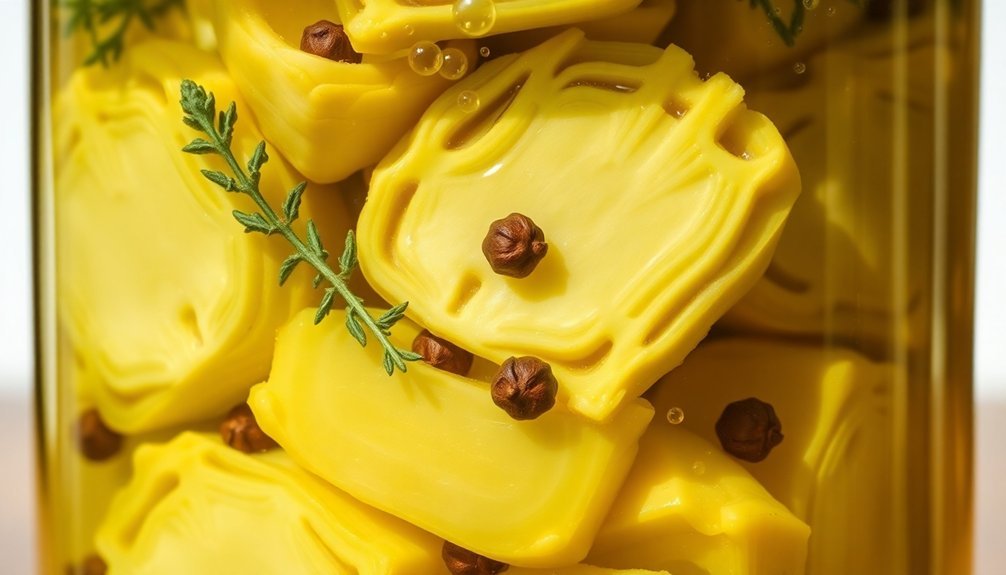
Nearly every oil preservation method relies on proper storage techniques to maintain quality and extend shelf life.
Glass and metal containers are best for oil storage, as they provide superior protection against degradation.
You'll find that storing oils in cool, dark places between 50°F and 70°F is essential to prevent oxidation and spoilage. When you use opaque or dark containers, you're protecting the oil from harmful light exposure that can accelerate degradation.
You're better off using refined oils for longer preservation periods since they've had impurities removed, reducing oxidation risks. While unrefined oils contain more nutrients, they won't last as long and require more careful storage.
If you're looking for peak shelf life, opt for oils high in saturated fats, like coconut oil, which can stay fresh for up to three years.
To maintain oil quality, you'll want to use airtight containers and implement a first-in, first-out rotation system.
Don't forget to filter out food particles and check regularly for signs of spoilage. You can enhance oil durability by choosing products with added stabilizers and antioxidants like Vitamin E or citric acid.
For best results, keep your oils away from strong-smelling substances to prevent odor absorption.
Understanding Traditional Preservation Methods
Throughout history, humans have developed ingenious methods to preserve food without modern technology. You'll find that ancient civilizations mastered four primary techniques that we still use today: drying, curing, freezing, and fermenting.
Drying dates back to 12,000 B.C. in the Middle East, where people used sun and wind to remove moisture from foods. When natural elements weren't sufficient, they'd create "still houses" with fire to dry fruits, vegetables, and herbs. Moisture removal helped prevent spoilage and allowed communities to store surplus food.
Curing took a different approach by using salt to draw out moisture, particularly effective for meats and seafood. You'll often see it combined with nitrates and sugar for enhanced preservation.
In cold climates, people discovered they could preserve food by burying it in snow, leading to the development of icehouses before modern refrigeration.
Meanwhile, fermentation and pickling emerged as methods that don't just preserve food but enhance its nutritional value. When you ferment foods, beneficial microorganisms create acid or alcohol that prevents spoilage.
Pickling, a form of fermentation, started when people noticed how food lasted longer in soured wine or beer.
Bacteria Growth Prevention
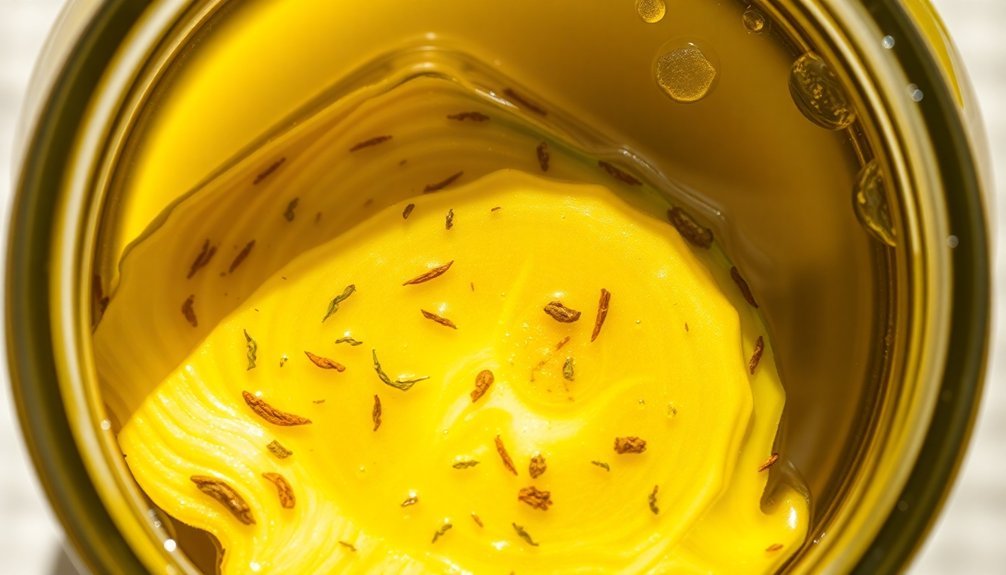
The oil in packed artichokes forms a protective barrier that creates an inhospitable environment for harmful bacteria to thrive.
You'll find that this oil coating effectively seals out moisture and oxygen, two essential elements that bacteria need for growth and reproduction. Dry environments prevent bacterial proliferation until moisture is introduced.
The natural acids present in the oil further strengthen this preservation method by creating conditions where bacterial activity is severely limited or stopped altogether.
Oil Creates Hostile Environment
Preserving artichokes in oil creates a remarkably hostile environment for bacteria through multiple mechanisms. When you submerge artichokes in oil, you're fundamentally creating a physical barrier that blocks oxygen and moisture, two essential elements bacteria need to thrive.
The oil's viscosity makes it difficult for bacteria to move and multiply, while also filling spaces between artichoke pieces to reduce bacterial colonization surfaces.
The oil's chemical properties work against bacteria in several ways. You'll find that oils, especially olive oil, contain natural antimicrobial compounds like antioxidants and polyphenols that can disrupt bacterial cell membranes.
The fatty acids in oils interfere with bacterial metabolism, while the oil's hydrophobic nature prevents water-soluble nutrients from reaching the bacteria, effectively starving them.
The anaerobic environment you create when packing artichokes in oil is particularly effective at preservation. Without oxygen, many harmful bacteria can't survive, while beneficial lactic acid bacteria may thrive.
The oil acts as a seal, maintaining these anaerobic conditions and preventing new oxygen from entering. Additionally, the oil can bind to bacterial enzymes, further reducing their metabolic activities and growth potential.
Acid Prevents Bacterial Activity
Working alongside oil's antimicrobial properties, acid creates another powerful defense against bacterial growth in preserved artichokes. When manufacturers add citric acid to artichoke preparations, they're creating an environment that's highly unfavorable for harmful bacteria like E. coli, Salmonella, and S. aureus. The acid reduces the pH below 4.6, making it nearly impossible for these pathogens to survive and multiply.
You'll find that acid works in multiple ways to protect your artichokes. It disrupts bacterial cell membranes, preventing essential nutrients from entering the cells and causing their metabolism to malfunction. The acidic environment also interferes with enzyme activity, which bacteria need for growth and survival.
When combined with other preservatives like potassium sorbate and sodium benzoate, the protective effect becomes even stronger.
The preservation process doesn't stop there. Lactic acid bacteria, which naturally occur during fermentation, produce additional antimicrobial compounds like hydrogen peroxide and bacteriocins. These compounds work together to create multiple barriers against spoilage.
When you store your oil-packed artichokes properly, this acidic environment continues to protect them, ensuring they remain safe and fresh for extended periods.
Storage and Handling Best Practices
Proper storage and handling of oil-packed artichokes directly impacts their longevity and flavor quality. You'll need to refrigerate opened jars at 32-40°F (0-4°C) and make certain the artichokes remain fully submerged in their marinade. For unopened jars, store them in a cool, dry place away from direct sunlight and heat sources.
| Storage Condition | Shelf Life |
|---|---|
| Unopened (Pantry) | Indefinite |
| Opened (Refrigerated) | 1-2 weeks |
| Frozen | Up to 6 months |
| Cooked Fresh | 3-5 days |
To maintain peak freshness, always use clean utensils when handling the artichokes to prevent contamination. You'll want to check regularly for signs of spoilage, such as cloudiness in the liquid, off-smells, or mold growth. If you notice any of these indicators, discard the product immediately. For longer-term storage, you can freeze artichokes for up to six months, though this may slightly affect their texture. Keep them in their original jar or transfer them to an airtight container, making sure they're properly sealed to prevent contamination and maintain quality.
Oil Selection and Quality
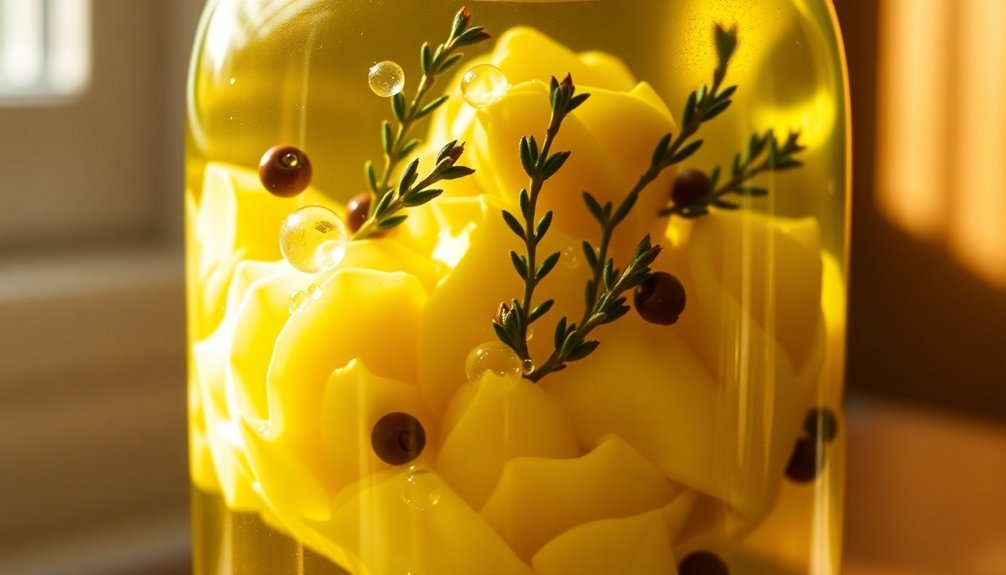
High-quality oil selection stands at the heart of successful artichoke preservation. You'll want to use extra virgin olive oil specifically, as it provides superior protection against spoilage while enhancing the artichokes' natural flavors. Unfiltered extra virgin olive oil can offer an even more balanced taste and fruity aroma to your preserved artichokes.
When selecting your oil, guarantee it's free from any signs of deterioration, stains, or discoloration. The oil you choose will serve as a vital barrier against contaminants while preventing oxidation that could compromise your artichokes' quality. You'll need to completely submerge the artichokes to maintain their texture and flavor over time.
Your oil selection will work in tandem with the acidic solution used in the preparation process. This combination creates a preservation environment that keeps your artichokes uniform in color and consistency.
The oil also complements other ingredients like lemon, parsley, and peppercorns, allowing the flavors to integrate fully. Remember that proper oil coverage isn't just about preservation – it's about creating a harmonious blend that maintains the artichokes' quality while preventing them from rising above the oil during storage.
Proper Preparation Steps
The step-by-step preparation process guarantees your artichokes will be perfectly preserved in oil. Start by selecting firm artichokes with tightly closed leaves, then cut off the top third and trim the stem to its pale core.
You'll need to remove the outer leaves until you reach the tender inner portion, which you can identify by its smooth texture. Don't forget to discard all dark green fibrous parts.
Next, you'll need to cook your artichokes until they're completely tender. You can either boil them in salted water with vinegar or braise them in a lemon-olive oil mixture.
Once they're cooked, let them cool and drain thoroughly. If you've braised them, consider browning the cut sides in a skillet for extra flavor.
To prevent browning during preparation, keep your trimmed artichokes in acidulated water.
When you're ready to pack them, arrange them tightly in jars and cover completely with olive oil, making sure to eliminate any air bubbles.
Add your preferred seasonings and leave a half-inch gap at the top. Check the jars the next day to confirm the artichokes remain fully submerged.
Sterilization and Safety Measures
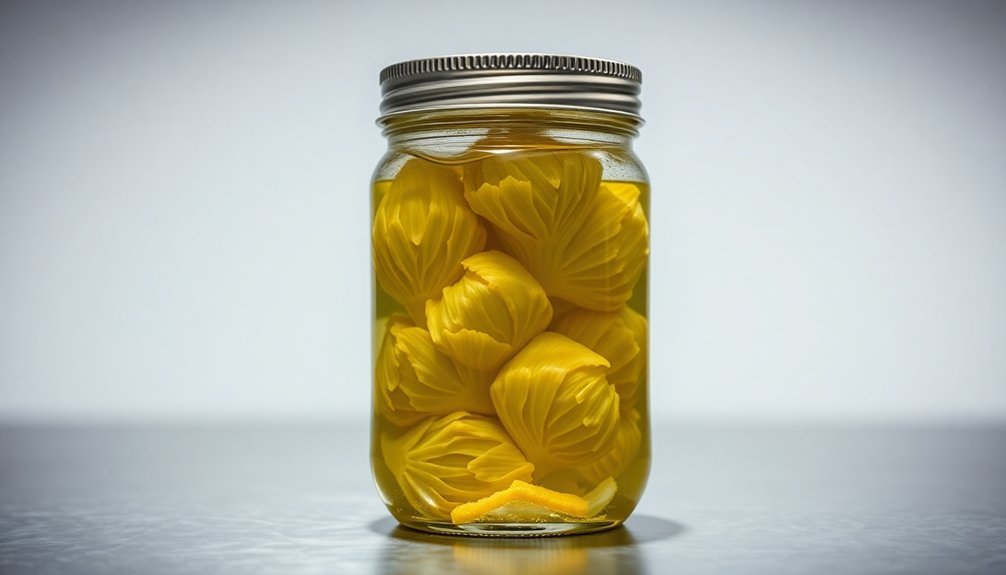
Guaranteeing food safety through proper sterilization is essential when preserving oil-packed artichokes. You'll need to start by boiling your jars and lids in water for 25 minutes, keeping them separate with a clean cloth to prevent cracking.
Once they're sterilized, use forceps to remove them without touching the inner surfaces, and let them dry completely upside down on a clean cloth.
Don't try to save money by using recycled containers – you must use specific canning jars and new lids that are free from damage, stains, or discoloration.
You'll want to inspect each jar and lid carefully before use to guarantee there aren't any chips or wear that could compromise your preservation efforts.
When you're packing your artichokes, you'll need to use high-quality extra virgin olive oil, which helps prevent oxidation.
Make sure you're submerging the artichokes completely and removing any air bubbles by gently pressing them down.
You should check your jars the day after preparation and add more oil if needed.
When stored in a dark, cool, dry place with proper sterilization measures, your artichokes can last up to six months.
Signs of Quality Deterioration
Proper preservation methods only work when you can spot signs of spoilage early. When examining your oil-packed artichokes, you'll want to check for several key indicators that tell you if they've gone bad.
First, inspect the container for any bulging, leaks, rust, or severe dents, as these suggest compromised packaging. If you're opening a jar or can, pay attention to any unusual smells – particularly sour, rancid, or metallic odors that shouldn't be there. The oil and artichokes should have a mild, pleasant aroma.
Look carefully at the artichokes themselves. They shouldn't show any mold growth, which can appear as white, green, or black spots. Watch for significant browning or discoloration, as these indicate quality loss.
The texture should be firm, not slimy or mushy – if you notice any stickiness or unusual consistency, it's time to discard them.
Don't ignore your taste buds, either. Even if everything else seems fine, an off taste means the artichokes aren't safe to eat.
Remember to keep the artichokes fully submerged in oil and properly refrigerated to prevent premature spoilage.
Maintaining Oil Levels
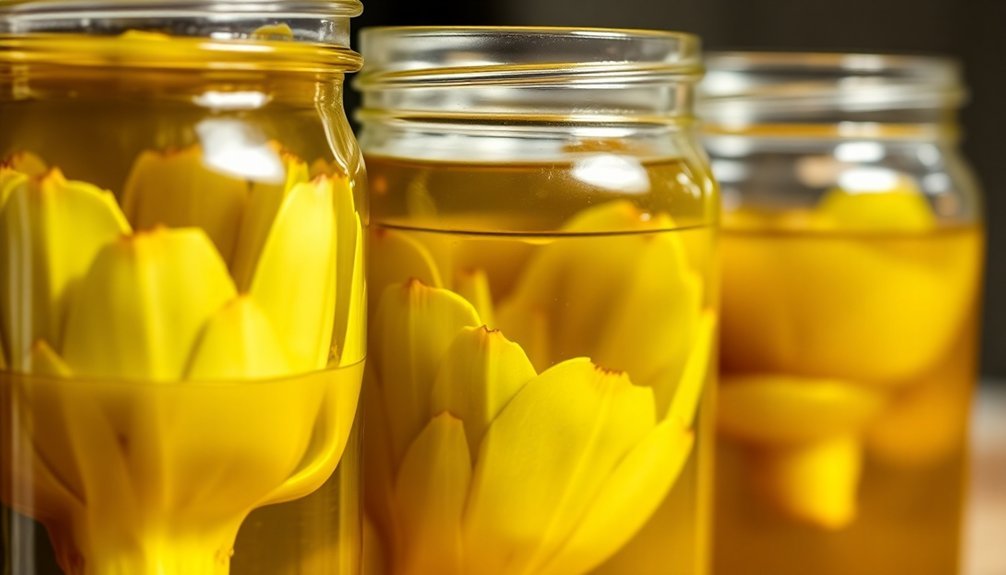
Successful preservation of oil-packed artichokes hinges on maintaining consistent oil levels in your jars. You'll need to monitor the oil coverage regularly to guarantee your artichokes remain fully submerged, preventing exposure to air that could lead to spoilage. After preparing your jars, check the oil levels within a few hours, as the artichokes may absorb some of the oil initially.
- Always maintain a ½-inch gap between the artichokes and the jar's rim
- Check for air bubbles by opening jars the day after preparation
- Top up oil levels immediately if artichokes aren't completely covered
- Monitor oil coverage weekly during the first month of storage
- Add more oil whenever you notice the levels have dropped
Don't forget to inspect your jars periodically throughout their storage period, which can last between two to six months. If you notice any artichokes peeking above the oil surface, add more oil right away.
This consistent maintenance of oil levels creates an effective barrier against contamination and helps preserve the artichokes' quality. Keep in mind that proper oil coverage, combined with appropriate storage conditions, is essential for maintaining the safety and flavor of your preserved artichokes.
Environmental Factors Affecting Preservation
During the preservation process, environmental factors play a significant role in maintaining the quality of oil-packed artichokes. To guarantee ideal preservation, you'll need to evaluate several environmental aspects that can impact both the artichokes and the oil they're stored in.
| Environmental Factor | Impact on Preservation |
|---|---|
| Water Content | Higher moisture levels increase spoilage risk and reduce shelf life |
| Energy Usage | Proper temperature control during processing affects preservation success |
| Storage Temperature | Consistent cool temperatures extend shelf life and maintain oil quality |
| Resource Management | Efficient packaging and storage methods prevent contamination |
You'll find that controlling these environmental factors isn't just essential for preservation but also impacts sustainability. For example, maintaining proper temperature control requires significant energy input, contributing to the product's carbon footprint of 0.86 kg CO₂-eq/kg. However, you can minimize environmental impact by choosing energy-efficient storage solutions and enhancing processing methods. The key is balancing preservation needs with environmental responsibility – from the initial processing stages through long-term storage. By understanding how environmental factors affect both preservation and sustainability, you'll be better equipped to maintain your oil-packed artichokes while reducing their ecological footprint.
Long-Term Storage Success
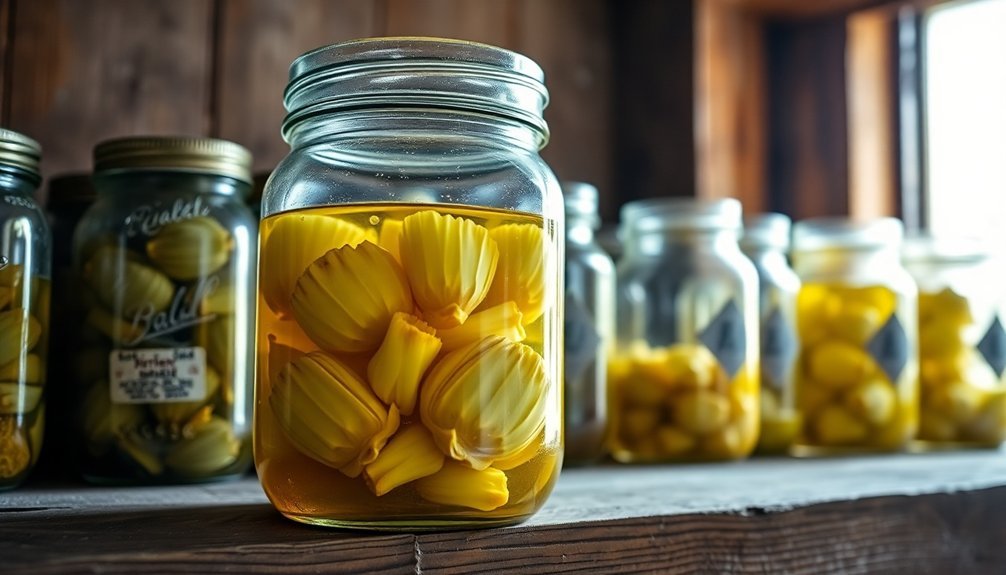
To guarantee your oil-packed artichokes stay safe for years, you'll need to sterilize all jars and equipment in boiling water for at least 10 minutes before use.
You should store your preserved artichokes at a consistent temperature between 50-70°F (10-21°C), away from heat sources and direct sunlight.
Check the oil levels monthly and top up as needed, making sure the artichokes remain completely submerged to prevent any exposure to air that could lead to spoilage.
Sterilization Best Practices
Proper sterilization stands as the cornerstone of safe, long-term artichoke preservation in oil. When you're preparing oil-packed artichokes, you'll need to follow strict temperature and pressure controls to guarantee food safety. The process typically requires heating the containers and artichokes to temperatures between 115-127°C using either an autoclave or retort sterilization method.
You'll want to make certain your sterilization process includes these critical steps:
- Clean and sterilize your jars using a boiling-water canner for at least 10 minutes, adjusting time for elevation.
- Fill jars with hot artichokes and oil, leaving proper headspace for expansion.
- Seal containers under sterile conditions using high-temperature sealing plates.
- Monitor and record time and temperature throughout the entire process.
- Cool and dry containers properly before storage to prevent rusting.
During the sterilization process, you must maintain precise temperature control through automated devices while following HACCP protocols.
Remember that container size affects sterilization times, so you'll need to adjust accordingly. Once sterilized, store your oil-packed artichokes in a cool, dry place to maximize their shelf life and maintain quality.
Temperature Control Tips
Maintaining precise temperature control opens the key to successful long-term storage of oil-packed artichokes. You'll need to keep temperatures consistently between 0°C and 7°C, with the sweet spot being around 0°C for ideal preservation. If you're aiming for extended storage periods up to 28 days, maintain temperatures between -1°C and +1°C.
You'll want to pair your temperature control with proper humidity management. Keep relative humidity between 90-100%, but don't let water accumulate between the artichoke bracts, as this can lead to mold growth. To achieve this balance, guarantee your storage area has adequate ventilation with 60-80 air circulations per hour.
Monitor your storage conditions regularly. You should check for any signs of brown discoloration or dry leaf tips, which indicate temperature or humidity issues. If you're using a controlled atmosphere system, keep CO2 levels below 5%.
Remember to maintain clean, hygienic conditions and regularly trim stems to keep the vascular system open. When you notice any temperature fluctuations, adjust your controls immediately – even brief deviations can greatly impact storage life and quality.
Oil-Level Maintenance Methods
For successful long-term storage of oil-packed artichokes, you'll need precise oil-level maintenance throughout the preservation process. Begin by completely submerging your artichokes in olive oil, leaving just enough headspace for expansion. You'll want to check the oil level after a few hours to guarantee consistent coverage and make adjustments as needed.
When layering your artichokes, arrange them tightly but without overlap, sprinkling peppercorns between each layer. This spacing technique prevents them from sticking together while maximizing the protective benefits of the oil barrier.
- Remove as much air as possible before sealing containers
- Store jars in a cool, dark place for best preservation
- Check oil levels periodically during storage
- Add more olive oil if levels drop below the artichokes
- Label containers with dates to track storage duration
You can maintain your oil-packed artichokes for 6-8 months in the freezer when properly sealed and covered. The oil acts as an essential barrier against freezer burn and oxidation, while proper storage containers help maintain the oil seal.
This preservation method works particularly well when you're preparing artichokes for Mediterranean-style dishes.
Ancient Mediterranean Preservation Wisdom
Ancient Mediterranean civilizations mastered food preservation through a remarkable blend of ingenuity and necessity. You'll find that their methods weren't just about keeping food edible – they were creating complex flavors and ensuring year-round sustenance. These civilizations developed preservation techniques that we still rely on today, particularly evident in how they preserved proteins and vegetables.
The Romans were especially skilled at food preservation, as documented in artifacts from Pompeii and other archaeological sites. They'd regularly use multiple preservation methods to maintain their food supply, particularly during winter months when fresh produce wasn't available.
| Method | Primary Benefit |
|---|---|
| Salt-curing | Draws out moisture, preventing bacterial growth |
| Sun-drying | Removes water content naturally |
| Pickling | Creates acidic environment hostile to bacteria |
| Fermenting | Develops beneficial microbes and complex flavors |
When you're enjoying oil-packed artichokes today, you're experiencing a preservation tradition that dates back thousands of years. These ancient techniques weren't just practical – they were revolutionary solutions that transformed Mediterranean cuisine and created the foundation for many of our modern preservation methods.
Frequently Asked Questions
Can Oil-Packed Artichokes Be Frozen for Longer Storage?
Yes, you can freeze oil-packed artichokes for up to 8 months. You'll need to store them in airtight containers, leaving headspace for expansion, and keep them at 0°F (-18°C) for best quality.
Are Oil-Packed Artichokes Healthier Than Water-Packed Varieties?
While oil-packed artichokes retain more antioxidants and vitamin C than water-packed ones, they're higher in calories due to the oil. You'll get better flavor, but consider your dietary needs when choosing between varieties.
Why Do Some Oil-Packed Artichokes Turn Slightly Pink?
You'll notice artichokes turning pink due to chemical reactions between their natural compounds and the acidic preservatives. Don't worry – it's completely normal and safe, caused by enzymes reacting with the marinade ingredients.
Can the Preservation Oil Be Reused for Cooking Afterwards?
You can reuse the preservation oil for cooking, but you'll need to strain it first. Make sure it doesn't smell rancid, store it properly in a dark container, and use it within a reasonable timeframe.
Do Different Artichoke Varieties Have Different Preservation Times in Oil?
Yes, you'll find that artichoke varieties preserve differently in oil due to their unique genetic makeup, moisture content, and biochemical composition. Some varieties like 'Spinoso sardo' naturally store better than others.
In Summary
Oil-packed artichokes last for months because you're fundamentally creating an anaerobic environment that prevents harmful bacteria from growing. When you've properly prepared and stored your artichokes in quality oil, you're using a time-tested Mediterranean preservation method that's both effective and delicious. Remember to keep the artichokes fully submerged, store them in a cool, dark place, and you'll enjoy their unique flavor for an extended period.

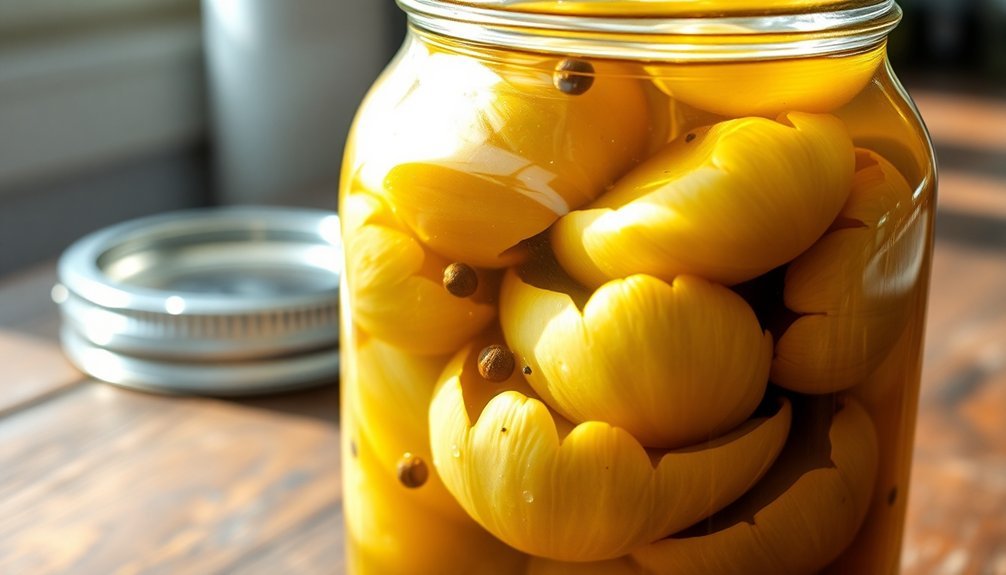
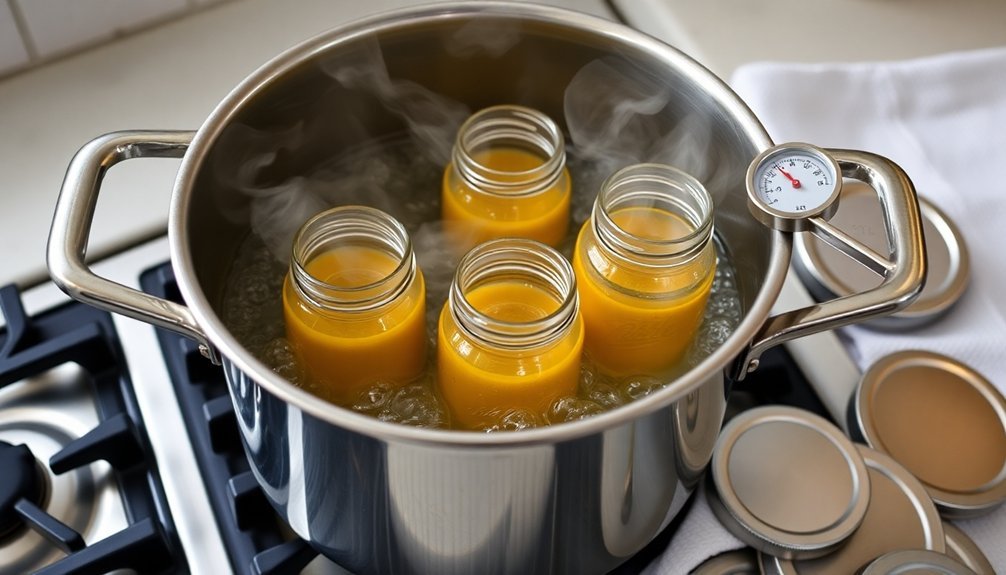

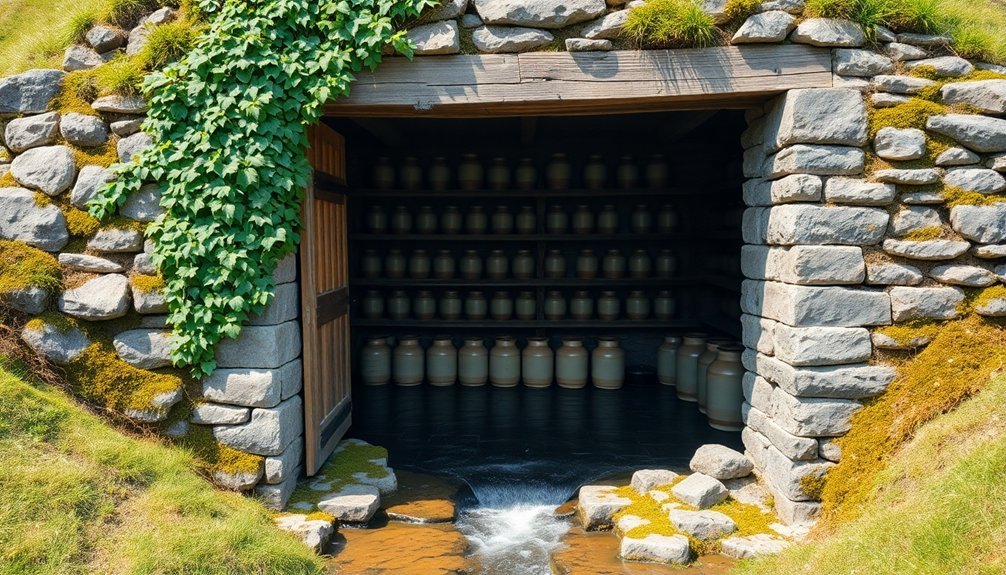
Leave a Reply